NEFF at NESAF
NEFF Forest Scientist Colleen Ryan reporting in on the eventful, educational…
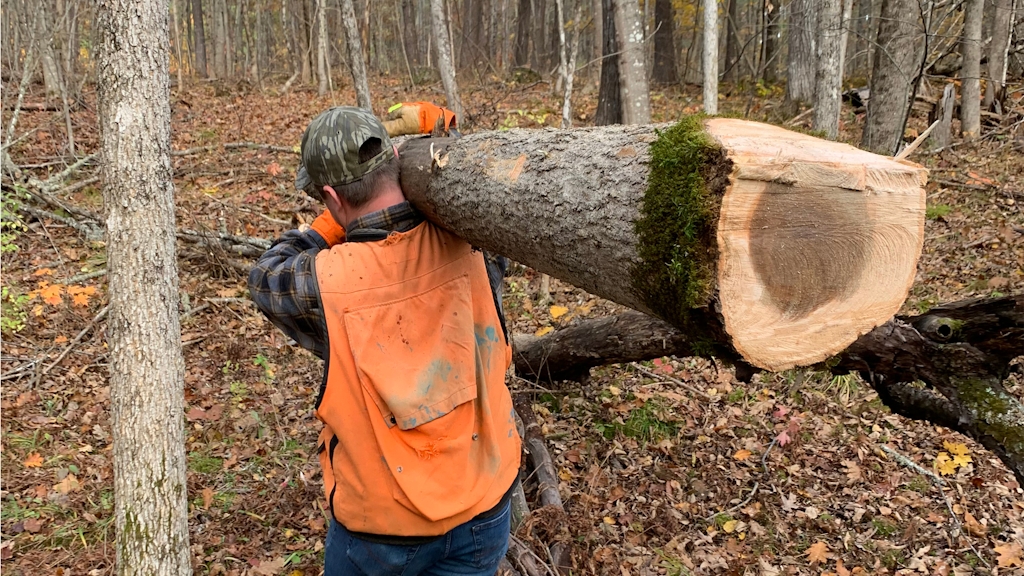
With axe in hand, he is looking for a Brown Ash tree, Fraxinus nigra, also known as Black Ash. There is no other tree like it in the northern forest.
He stops to assess one tree, then another. Rubbing a hand down the spongy, cork-like bark can confirm if it is a Brown Ash tree. It’s not any Brown Ash he’s hunting. It’s a straight one, free of knots, a true basket tree. He moves deeper into the woods, repeating a journey taken by generations of Tribal basketmakers before him.
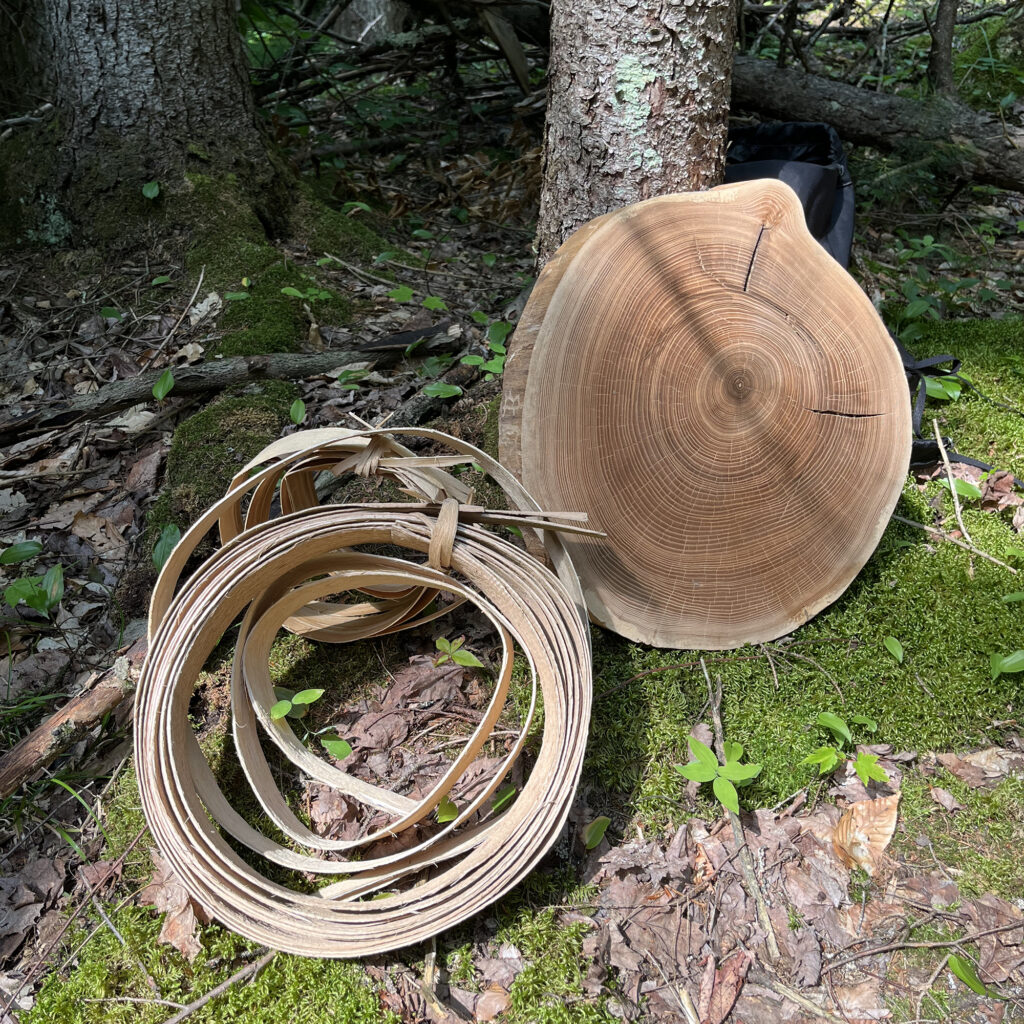
Each annual ring of Fraxinus nigra, as shown in the tree cookie on the right, is bordered by uniquely large pores that allow volumes of water and nutrients to flow from the roots to the leaves. When logs are pounded, the porous borders easily separate the annual growth into thin, flexible splints used in basketmaking, as shown on the left in the photo. Photo courtesy of APCAW.
Newly harvested Brown Ash bends beyond a believable breaking point and is as pliable as leather and as slippery as a slug. The wood is perfectly supple and light, allowing for inventive basket designs. More than raw material, Brown Ash trees figure in one of the creation stories of the Eastern Wabanaki, the People of the Dawnland, which includes the Maine-based Passamaquoddy, Penobscot, Mailiseet and Mi’kmaq Nations. It is from the Brown Ash that the People came into the world, dancing and singing, according to the story.
And it is Fraxinus nigra, along with the other Fraxinus species, including White Ash and Green Ash, that is threatened by a tiny, shiny bright green insect. The Emerald Ash Borer (EAB) arrived in the U.S. by ship two decades ago. It’s lethal to ash and has no North American predators to keep it in check. Researchers predict eight billion ash trees are at risk in the United States, and 99 percent of all Fraxinus species will die in the most heavily infested areas across eastern North America by mid-century. For the Wabanaki, who have been here at least 100 centuries, the loss of Brown Ash can’t be measured in dollars or board feet. It’s a fundamental cultural loss.
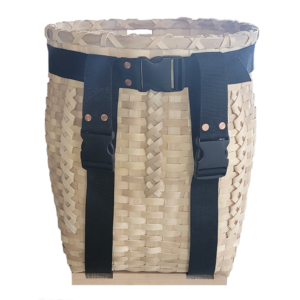
A fancy but functional Brown Ash pack basket. Photo by Wabanaki Mi’kmaq Basketmaker Richard Silliboy.
Brown Ash grows across the state, often clustering along stream corridors in mixed stands or in low-lying soggy soils. The logs, pounded with the blunt head of an axe, separate the wood by annual rings that yield flexible layers that can be split and split again for basket making. In each Brown Ash stand, only about 5 percent of the trees are basket quality.
Not every basket tree is right for every kind of basket. Some logs yield pliable splints as thin as 1/32nd of an inch that can be woven into delicate art baskets threaded with sweetgrass, or twisted to create a pattern in the weave called curl work, or shaped into baskets that look like corn stalks, acorns and strawberries.
Other logs yield wider splints that are woven into utility baskets. Brown Ash dries hard, strong and light. Potato baskets, which were commonly used by commercial growers in northern Maine in the 20th century, hold 25 pounds of potatoes with ease.
For most of the 20th century, roadside markets in Bar Harbor and elsewhere along the Maine coast offered fancy baskets, picnic, and pack baskets for sale to summer tourists. Many Wabanaki relied on the basket trade for crucial family income. Some still do.
When basketmaking fell out of favor in the marketplace, the Nations formed the Maine Indian Basketmaker’s Alliance with funding from the Native Arts and Cultures Foundation to successfully promote ash basketry and train new generations. The artistry evolves, as new basketmakers continue to blend the practical and the creative to reflect the life bond between tree and Tribe.
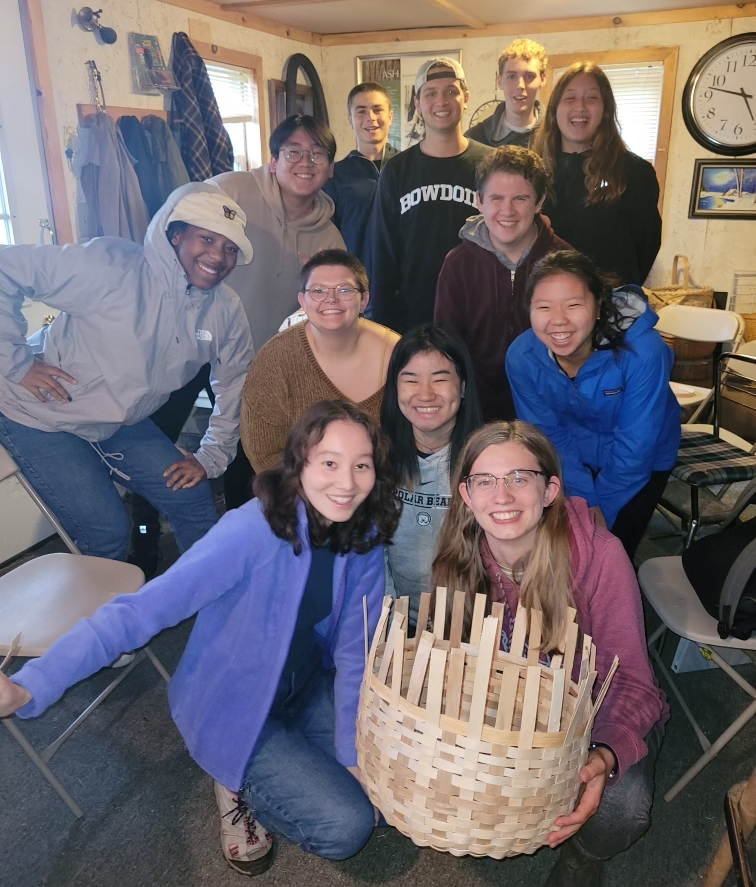
Bowdoin College students in Brunswick, Maine work with Wabanaki basketmakers to complete a potato basket. Photo by Wabanaki Mi’kmaq Basketmaker Richard Silliboy.
So small that three can fit on the head of a penny, the Emerald Ash Borer stowed away as larvae in wooden shipping pallets that landed in Great Lakes ports two decades ago, then hitched eastward through firewood sales and through ash trees sold by nurseries. Maine took early action to slow the spread by restricting the movement of firewood from infested areas, but nothing was going to stop it. In 2018, it came across the northern Maine border. In 2019, EAB entered southern Maine and the Maine Forest Service established a quarantine prohibiting the movement or sale of all firewood from the affected zones in or outside the state to areas where EAB has not been detected. In 2023, EAB was found in central Maine. A proposal to expand the quarantine is under review.
Over the past 20 years, key players and partners rallied forest researchers, Wabanaki basketmakers, state and federal foresters, land stewards and forest caretakers to fight back long before the Emerald Ash Borer arrived in Maine, an effort that evolved into the Ash Protection Collaboration Across Wabanakik (APCAW). Their plans are to map Brown Ash stands across the state, develop and test strategies to slow the spread of EAB, test specific forest practices to create more diverse forest structure that may increase resilience within the Brown Ash stands, identify or develop potential genetic variations of Brown Ash that are resistant to EAB, and save seed stock in order to replant Brown Ash now and in the future.
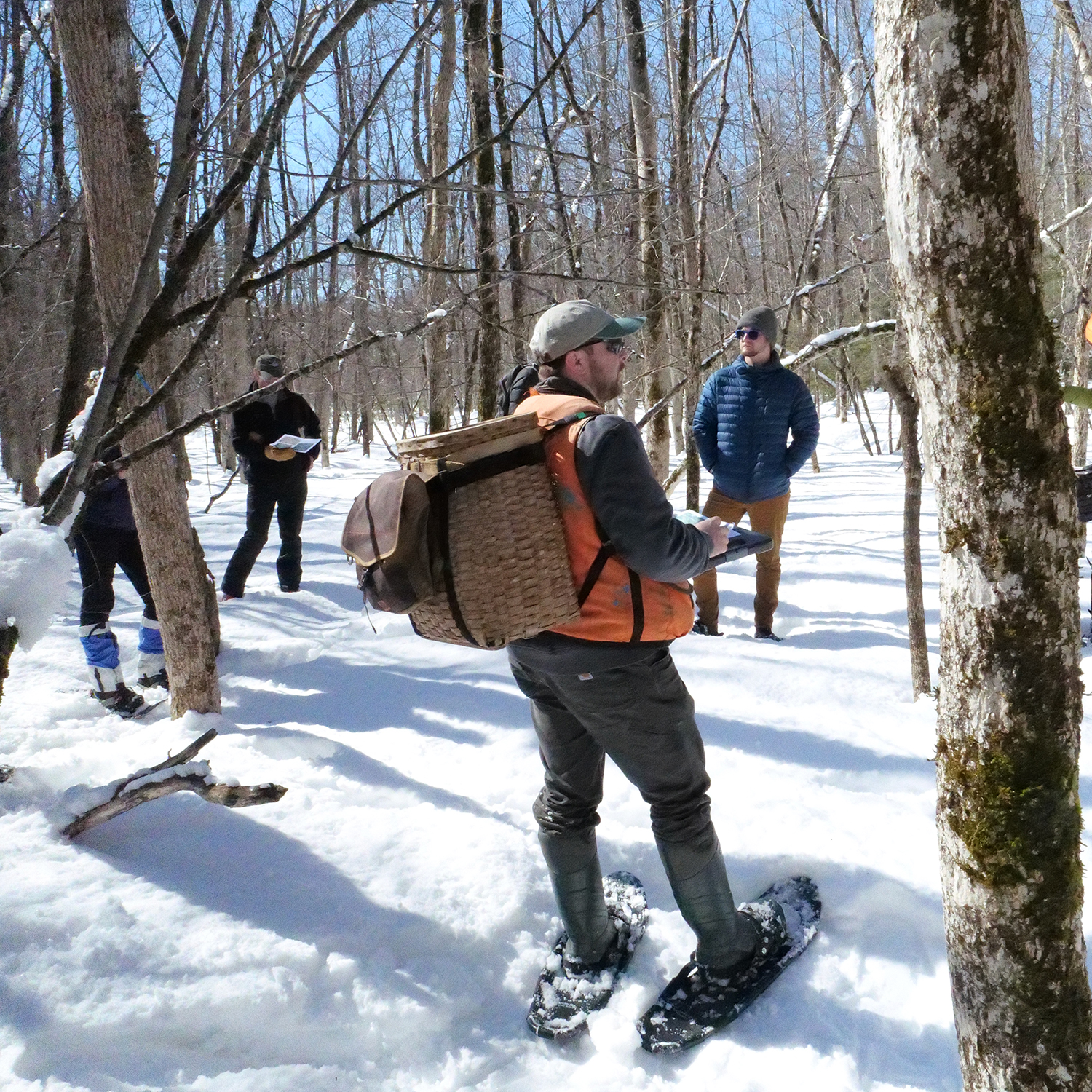
Tyler Everett trains volunteers on how to identify and map Brown Ash stands. Photo courtesy of APCAW.
University of Maine professor John Daigle, of the Penobscot nation of the Wabanaki, leads the research team that focuses on Tribes and partners working together to prevent, detect, and respond to EAB in Maine. Daigle said the Wabanaki will decide where the seeds will be stored and which pest management strategies to promote.
“The approach is landscape-wide and developed in partnership with the Tribal nations, so the strategies meet Tribal approval,” said Daigle. While the cultural knowledge informing decision-making is a priority, said Daigle, so is participation by all woodland-owners across the state.
To that end, APCAW offers programs to train land trust staff, foresters, private landowners, and the public on how to identify, monitor and manage Brown Ash, including how to collect and store seeds for future use.
The hope is that action taken on Tribal lands spreads to other forest landowners to create the landscape-level actions needed to protect ash as a component of the forest, said Daigle.
The general recommendation from forestry professionals is to not cut ash trees down ahead of an infestation, according to Tyler Everett, of the Mi’kmaq nation of the Wabanaki. A doctoral student in forestry at the University of Maine, Everett is helping move the APCAW effort forward through work he started as an undergraduate when he developed a protocol for mapping Brown Ash stands. APCAW teaches woodland owners how to do an inventory and map Brown Ash stands to get a more complete picture of where basket trees are growing across the state.
Cutting down ash trees forces the Eastern Ash Borer to fly further to find a tree and increases the potential for it to spread, said Everett.
Keeping ash alive and standing now may help keep ash trees as part of the forest later. Some ash may be resilient and there is potential that individual trees may have varying degrees of resistance to the borer.
“We would never get a chance to learn that or not, if that tree is [cut and laying] on the ground,” said Everett.
For APCAW, every option is open for discussion among the Tribes and partners, including those that spark controversy like bio-controls and pesticides.
Biological controls using non-stinging parasitic wasps that range in size from that of a fruit fly to no larger than the period on this page have been extensively studied and are being used across many states. Limited pesticide use, which is expensive and must be injected into the tree, is on the table, too, though it appears most efficient for individual trees.
“Large overstory ash trees are going to die,” said Everett, noting that the biological controls put the next generation of Brown Ash trees in a better position to survive and thrive over the long term. It won’t stop the ash borer, but it could contain it in smaller outbreaks.
“There are always some risks with bio-controls, but some are showing promise in thirty-three states,” he said, noting that risks and benefits were weighed in national research trials. “Bio-controls do offer an opportunity to buy some time by maintaining some ash on the landscape.”
That deliberate process reflects APCAW’s integrated pest management approach to problem solving. They aren’t relying on just one strategy.
Everett conducts his own research through a Tribal lens. He established four test sites across the state in forest stands with notable Brown Ash components. After testing for presence of the borer and, finding none, he inventoried the tree species on site as a baseline for monitoring changes over time. The next step is creating small openings, or gaps—ranging in size from half a tennis court to a whole court—and creating long strip-openings as narrow as the pavement on a two-lane road that follow stream corridors where Brown Ash grows.
Brown Ash is not tolerant of shade. The light provided by the openings will encourage new growth and allow established small Brown Ash trees to grow bigger within the gaps. Tyler will monitor the presence of EAB as the forest grows and changes. He expects the mature trees to succumb and hopes the young trees, or at least some of them, will survive.
The Wabanaki are social and intergenerational in nature, and Everett’s research includes social components. He surveyed foresters and loggers on how they are integrating Brown Ash into their forest management decisions and is working with the Tribal nations in Maine to create a Tribal-centric framework for decision-making that can help with EAB management decisions and be used to address future problems that threaten livelihoods and life ways.